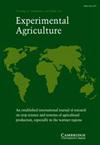利用遥感多光谱图像和近叶遥感预测青贮玉米蛋白质含量
IF 1.9
4区 农林科学
Q1 Agricultural and Biological Sciences
引用次数: 0
摘要
摘要青贮玉米蛋白质的及时估算为农民制定氮肥管理和收获时间的优化策略提供了有效的决策。因此,本研究旨在研究是否可以使用来自无人机遥感多光谱(520–900 nm波长)图像的营养指数(VI)和土壤植物分析发展(SPAD)绿色指数来检测青贮玉米的叶蛋白浓度(LPC),作为各种氮含量(推荐剂量的0、50、100和150%)的函数。主成分分析(PCA)结果表明,LPC与各发育阶段的叶片绿度指数高度相关。此外,LPC与所研究的大多数VI高度相关。PCA聚类显示了N速率的有意义模式。较高的LPC值、VI和绿色指数更集中在较高的氮(N100%和N150%)部门。氮反射指数(NRI)被确定为监测和预测青贮玉米田LPC的最重要的VI,在八叶领(V8)(R2=0.81,p≤0.01)和雄穗(VT)(R2=0.98,p≤0.001)阶段与LPC都表现出很强的多项式关系。此外,在VI中,归一化差异植被指数(NDVI)与VT中的LPC呈显著的线性回归关系(R2=0.80,p≤0.01)。研究结果表明,无人机拍摄的多光谱图像和SPAD近端传感提取的VI有很高的潜力帮助农民快速诊断青贮玉米的LPC,符合精准农业的目标。本文章由计算机程序翻译,如有差异,请以英文原文为准。
Predicting protein content of silage maize using remotely sensed multispectral imagery and proximal leaf sensing
Abstract Timely estimation of silage maize protein provides an effective decision to adapt optimized strategies for nitrogen fertilizer management and also harvesting time for farmers. So, this research aimed to investigate whether using vegetative indices (VIs) derived from UAV remotely sensed multispectral (with 520–900 nm wavelengths) imagery and also Soil Plant Analysis Development (SPAD) greenness index can be used to detect the leaf protein concentration (LPC) of silage maize, as a function of various nitrogen rates (0, 50, 100, and 150% of recommended dosage). Results of principal component analysis (PCA) suggested that LPC was highly correlated with leaf greenness index in all developmental stages. In addition, LPC was highly correlated with most of the VIs investigated. A PCA clustering showed the meaningful pattern of N rates. Higher LPC values, VIs, and greenness index were more concentrated in the higher nitrogen (N100% and N150%) sectors. Nitrogen Reflectance Index (NRI) was identified as the most important VIs to monitor and predict LPC in the silage maize field, showing a strong polynomial relationship with LPC in both eight-leaf collar (V8) (R 2 = 0.81, p ≤ 0.01) and tasseling (VT) (R 2 = 0.98, p ≤ 0.001) stages. In addition, among VIs, the Normalized Difference Vegetation Index (NDVI) demonstrated a significant linear regression relationship with LPC (R 2 = 0.80, p ≤ 0.01) in the VT. Findings suggested the high potential of VIs extracted by UAV-taken multispectral imagery and also SPAD proximal sensing to help farmers rapidly diagnose LPC in silage maize, in line with the objectives of precision farming.
求助全文
通过发布文献求助,成功后即可免费获取论文全文。
去求助
来源期刊

Experimental Agriculture
农林科学-农艺学
CiteScore
2.50
自引率
6.20%
发文量
29
审稿时长
24 months
期刊介绍:
With a focus on the tropical and sub-tropical regions of the world, Experimental Agriculture publishes the results of original research on field, plantation and herbage crops grown for food or feed, or for industrial purposes, and on farming systems, including livestock and people. It reports experimental work designed to explain how crops respond to the environment in biological and physical terms, and on the social and economic issues that may influence the uptake of the results of research by policy makers and farmers, including the role of institutions and partnerships in delivering impact. The journal also publishes accounts and critical discussions of new quantitative and qualitative methods in agricultural and ecosystems research, and of contemporary issues arising in countries where agricultural production needs to develop rapidly. There is a regular book review section and occasional, often invited, reviews of research.
 求助内容:
求助内容: 应助结果提醒方式:
应助结果提醒方式:


